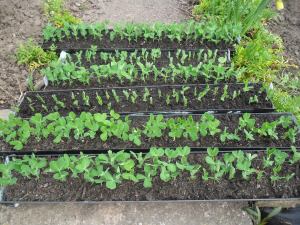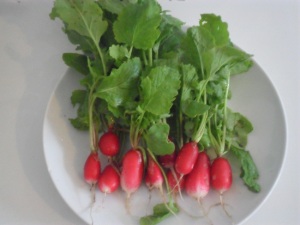When I first started to grow vegetables I really needed the information to be in one place, so I could look it up easily. However, I found I had to search for lots of little bits of information, scattered between internet sites and books. It used to take me a long time to find the information I needed.
I thought it would be useful to have this information altogether in one place. So for the benefit of the UK gardeners, I write a list of things to be done each month and any useful information I can think of.
It is worth remembering that different parts of the UK have different weather conditions e.g. the last frost is expected earlier in the south than the north.
.
May
Lighter evenings mean we have longer in our gardens and with temperatures rising in May, we should experience some beautiful sunny days. However there may still be some overnight frosts which can kill tender plants.
May is a good month for sowing seeds outside, but only if the ground has warmed up or the seeds will just rot in cold wet soil.
Be careful not to sow all your seeds in one go, as you will end up with a ‘glut’ of vegetables and salads that are all ready to eat at once. It is far better to ‘stagger’ your sowings to spread out your harvests.
.
Vegetables and salads to harvest:
Lettuces, radishes, mizuna, and overwintering spring onions can be harvested this month, together with spring cabbages, spinach beet, swiss chard and spinach leaves. Rhubarb, turnips, cauliflowers, asparagus, tiny globe artichokes and if you are really lucky you may have garlic while it is still ‘green’.
.
Vegetables and salads to sow indoors:
Sweetcorn, French beans, corn salad, beetroot, runner beans, cucumbers, patty pans, pumpkins, courgettes and gherkins. Herbs include coriander, basil and parsley.
.
Vegetables and salads to sow outdoors:
Turnips, kale, Florence fennel, cauliflowers, peas, mangetout, swiss chard, spinach beet, spring broccoli, brussel sprouts, swedes, carrots, radish, rocket, kohl rabi, calabrese, beetroot, cabbages (red and white), chicory, land cress, lettuces and salad leaves, oriental leaves, spring onions.
.
Things to plant:
Be careful when you plant out tender seedlings this month, as there can still be frosts in some areas up until the end of May. If you have planted out seedlings and a frost is forecast, make sure you cover them with fleece or cloches, though it is better to wait to plant them out, if at all possible.
Also, make sure all seedlings are fully ‘hardened off’ before you plant them out. ‘Hardening off’ is a process where you gradually acclimatise the plants to outside temperatures and conditions over two or three weeks. You can find details of how to do this on the RHS website here.
Brassica’s can now be planted out, these include brussel sprouts, red and white cabbages, cauliflowers, kohl rabi, spouting broccoli, calabrese and kale. Leeks and peas can be planted out too. Lettuces and salad leaves can be planted but beware of frosts and cover them if necessary. Towards the end of the month, when frosts have passed, you can plant aubergines, peppers, chilli’s, outdoor cucumbers, pumpkins, courgettes, marrows, patty pans, runner beans, French beans, asparagus pea, celery, celeriac, summer squashes, sweet corn, tomatoes, florence fennel and sweet potatoes.
Offsets from globe artichokes should be planted this month and rhubarb plants can be transplanted. Strawberry plants can still be planted this month, together with blueberry plants. Cape gooseberries can also be planted but they need protection from frosts.
Herbs that can be planted outside are thyme, parsley, dill, fennel, borage and coriander.
.
Jobs to do:
Keep sowing seeds and pricking out seedlings.
Water seedlings when required, as May can be a dry month.
Harden off seedlings ready to plant out.
Watch out for late frosts and protect plants if need be.
Hoe and weed regularly.
Weed and mulch fruit bushes.
Thin out seedlings, so they have room to grow.
Support broad beans to stop them from falling over.
Earth up potatoes.
Pot on plants that are becoming too big for their pots, but are not ready to be planted out e.g. squashes, before they become ‘pot-bound’.
Pick off the flowers on new strawberries, so the plant puts its energy into making a good root system instead of producing fruit.
Remove new raspberry suckers or shoots that are unwanted. If your canes become too thick and dense it stops the sunlight and air from getting to the inside canes, which can cause disease or under-developed fruit.
Feed globe artichokes with a high potash fertiliser and mulch them.
Transplant vegetable seedlings, keeping an eye out for frosts.
Weed and mulch around fruit bushes.
Remove any dead, diseased leaves from strawberry plants.
Put up supports for climbing peas and climbing French beans and runner beans.
.
May pests and diseases:
Pigeons are hungry and will eat brassicas, peas, strawberries and even lettuces if they are really hungry, so keep them netted.
Slugs and snails will eat newly planted seedlings. Wet weather will bring them out, especially at night.
Flea beetle can be a problem this month, leaving tiny little holes all over leaves (especially in dry weather). They especially like brassica seedlings. Plants do usually recover, though when they are badly affected it can stunt their growth. Keep the seedlings moist so they grow as strong as possible.
Cabbage root fly can cause a problem by laying their eggs at the base of brassicas, so it is best to fit cabbage collars around the base of them.
.
Check gooseberry and currant bushes for the sawfly larvae which look like caterpillars and pick them off. Also, check for currant blister aphid (you can see an example here) and American gooseberry mildew (you can see an example here).
Blackfly love the soft new growth on broad beans. As soon as the first tiny pods start to form at the base of your plants, ‘pinch off’ the top couple of inches of your broad bean plants, which will help to deter the blackfly.
Protect early carrots from carrot flies, as they are laying their eggs this month.
Lay a mulch of dry straw around your strawberries, this will keep the strawberries off the wet soil (which prevents them from rotting) and stops annual weeds from germinating.
Check apple and pear trees for canker (you can see an example here).
Hang pheromone traps in apple trees to attract and catch the male codling moths, to prevent them mating with a female this month.
Also hang pheromone traps in plum trees to attract the plum moths, again to prevent them from mating.
.
Thank you for reading my blog today.













Reblogged this on Linda's wildlife garden and commented:
awesome post and thank you for sharing Joanne
Thanks for your support and reblogging this post Linda. Hope you are well.
your welcome have a blessed weekend and I am good thanks
WOW….I have spent a lot of time looking through your very informative and helpful advise and tips. I never really understood what apple canker was , now I know. I have that currant blister aphid on our red currant and never knew what it was, I just cut off the affected leaves, but now know it’s not fatal. Thank you so much for all this helpful information,Joanne.Looking forward to reading more of your posts x
What a lovely comment, thanks Joanne.
Wow this is really helpful. Thank you. It is my 2nd year helping on a shared allotment and am learning as we go. Although the old guys really just want my partner and I to do what we are asked and I want to learn. It is great to learn on the job but to have all these jobs here will help me earn extra brownie points as I won’t have to ask so many questions I know I asked last year. Thanks again very informative and helpful. xXx
That’s ok Rutilly and it’s lovely to hear from you.
Thank you so much for the post it is so helpful, the hungry gap vegs are really useful to plan in for next years “empty” veg months.
Sue
Glad to be of help Sue. Happy gardening!
Thanks for another really useful post : )
I’ve just bought a packet of nasturtium seeds after reading one of your earlier posts about companion planting and growing these with your beans. Would you suggest planting at the same time, do they need to be flowering together? Thanks Marise
I am so glad to have found your blog. I have just made raised veg beds and although I have grown veg before I am now keen to do it properly and at the right time. I don’t want to be asking myself why I have no leeks or sweet corn later on. (Because I forgot to put them in.) This post is really helpful. Thanks. I will be back.
Thanks Chloris and welcome to my blog. If you have any questions, pls let me know as I’m always glad to help.
This is SUCH a helpful blog, thank you !!! We have just taken delivery of our first polytunnel. The whole family including our Grandchildren, will all be involved in cultivating our own fruit and veg. Exciting times.
Hi Pip and welcome. How exciting for you all, you will love it! Have you seen my post ‘A year of growing in my polytunnel-A review’ as it may be helpful: https://notjustgreenfingers.wordpress.com/category/gardening-a-year-in-my-polytunnel/